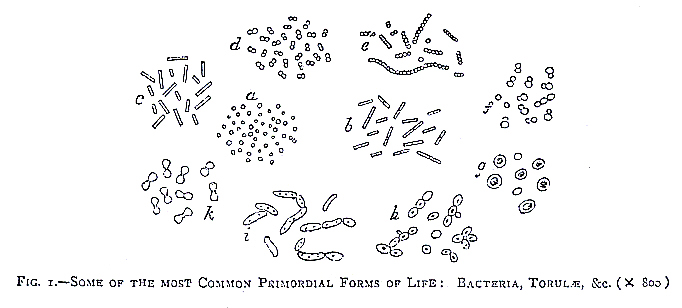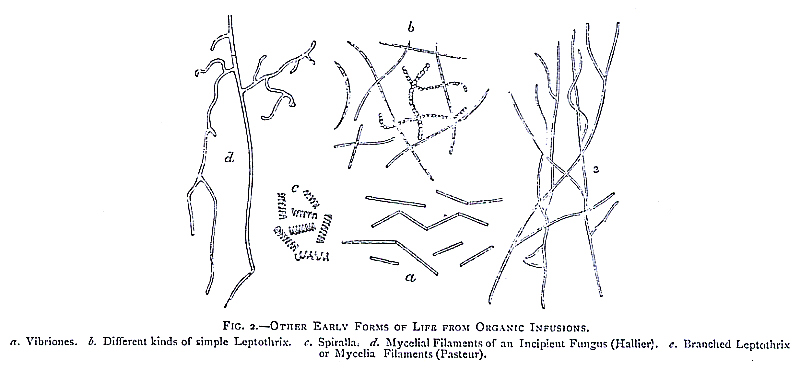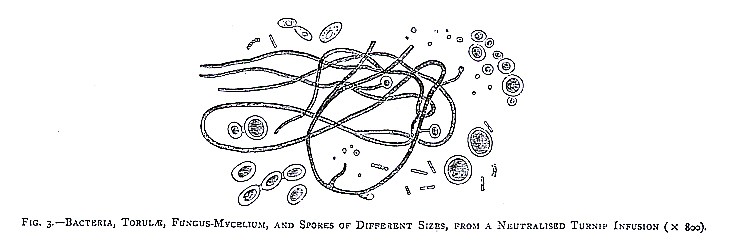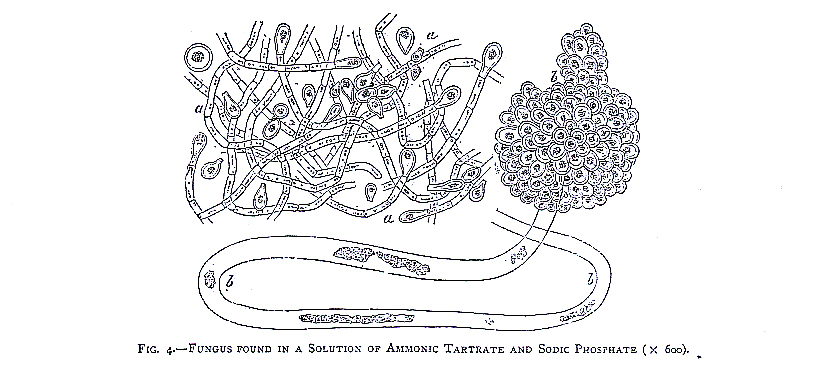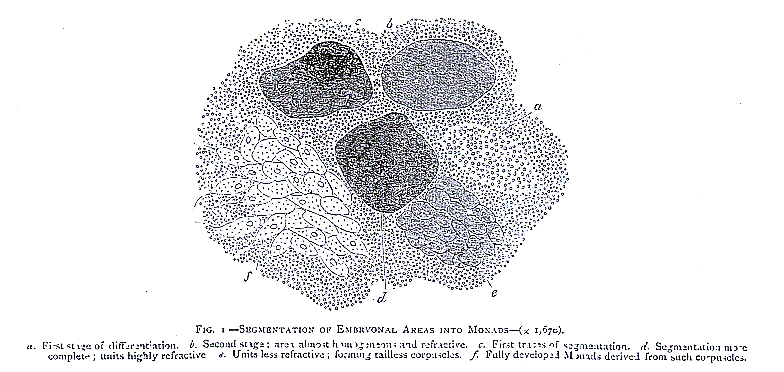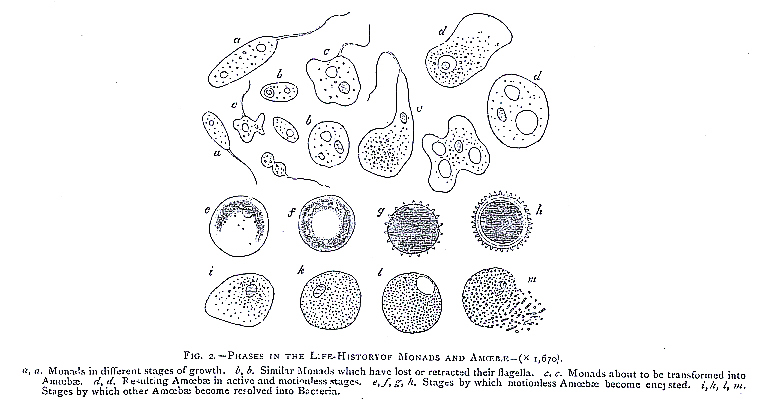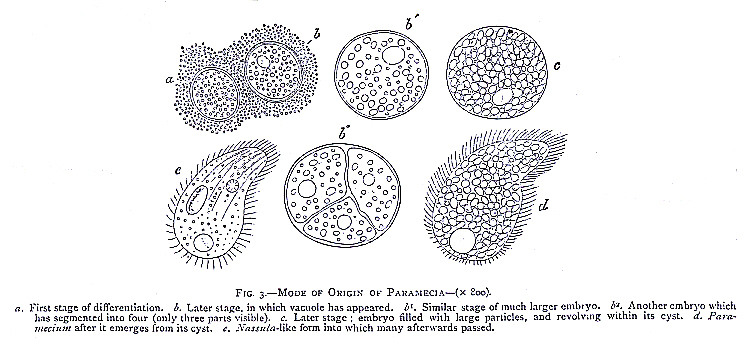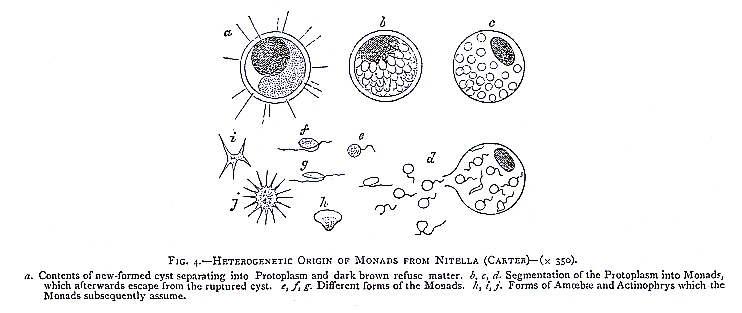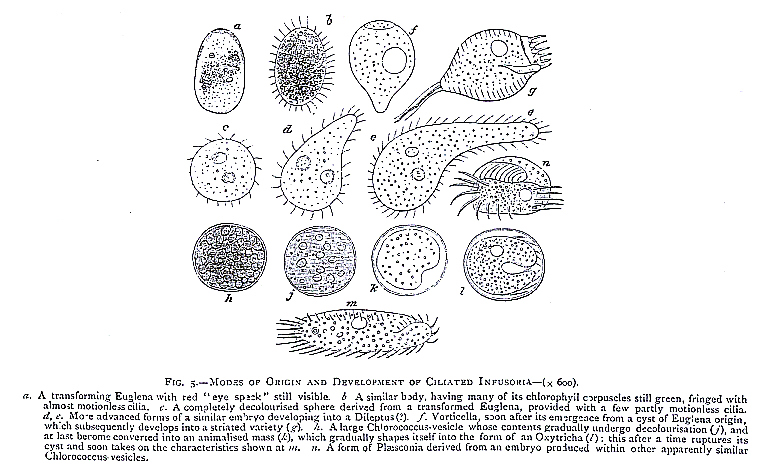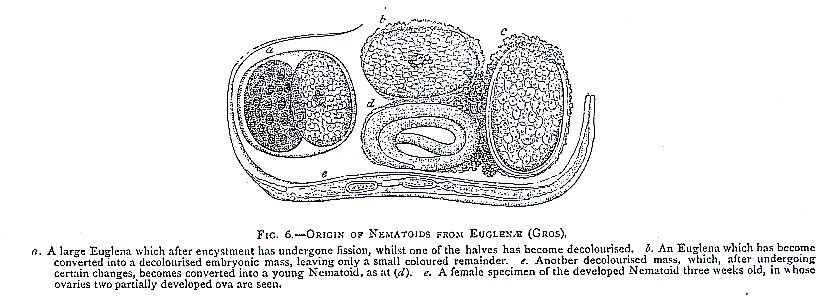|
Russel Wallace : Alfred Russell Wallace (sic)
After a careful perusal of this important and suggestive work, a prominent feeling is one of regret that its value and popularity should be endangered owing to purely technical faults of composition and arrangement. It is so full of curious and novel facts and experiments, it contains so much excellent reasoning and acute criticism, and it opens up such new and astounding views of the nature and origin of life, that one feels it ought to and might have ranked with such standard works as the "Origin of Species" and the "Principles of Biology," if equal care had been bestowed upon it as a literary composition. But, unfortunately, it altogether lacks their powerful condensation and lucid arrangement. Its vast masses of facts are stated too diffusely, and are often so scattered as to lose the cumulative force that might have been given to them; while the arguments are broken up and weakened by a too minute classification of the subjects treated, leading to repetition and confusion rather than to clearness. Haste of composition is further indicated by the quantity of additional matter given in foot-notes that should have found a place in the text; and we often find it difficult to follow the special argument in hand, or to see the connection and relevance of much of the detailed evidence brought forward. Notwithstanding these defects, which will undoubtedly diminish its popularity, it is a book which will make its mark, and must produce a powerful sensation. It brings together a large body of facts, either new or hitherto almost ignored, which, unless they can be otherwise explained, prove much more than the mere production of low living organisms from dead matter; for these low forms have been seen to combine and give rise to higher forms, and these again to still higher and more complex organisms. Vegetable cells or their contents develop into various low animals; while animal as well as vegetable organisms of specialised forms and some elaboration of structure seem to be mutually transformable by processes quite unlike any of the hitherto accepted modes of multiplication or reproduction. These processes have been traced stage by stage, so that there seems no possibility of mistake; and they do not rest on the observations of Dr. Bastian alone. Facts of this nature have been repeatedly published for more than twenty years by many Continental and English naturalists, but, being so entirely opposed to current theories, have been all silently ignored, just as true facts and careful observations relating to the antiquity of man were so long ignored. Our author has, however, repeated and tested many of these observations, and finds them to be strictly accurate; and they harmonise perfectly with the views on the origin of life founded on his own experiments, and so energetically advocated by him. Looked at merely as curiosities of science, and as an unveiling of mysteries hitherto thought to be inscrutable, these observations are of supreme interest; while their importance in connection with modern theories of development and the origin of species can hardly be overrated. Setting aside all the prejudices and dogmas of the existing schools of biology, it must be admitted that the views here presented of the perpetual origination of low forms of life now, as in all past epochs, is in perfect harmony with the doctrine of evolution, and does away with many of the physical and geological difficulties which are undoubtedly among the most serious which beset those special views of the origin of life which Mr. Darwin holds, but which are by no means necessary inferences from his theories. The present work is essentially one that to be judged soundly cannot be judged hastily. The subject is of overwhelming importance to the future progress of scientific biology, and the facts and observations on which it is founded are so numerous and so precise, and have been tested by such a body of distinct and competent observers, that no a priori arguments and no authoritative dicta can have any weight against them. Observation alone can demonstrate whether they are facts or delusions. They will no doubt be fully criticised by those whose special studies render them competent to do so; but if the past history of science has any value whatever, the result cannot be doubtful. Facts observed and tested by a succession of careful and accurate observers, such as those whose evidence is adduced by Dr. Bastian, have never yet proved to be fallacies. We now propose to lay before our readers a sketch of the more interesting matters treated of in these volumes, citing a few of the most striking of the new facts and the most important of the arguments founded upon them. More than half of the first volume is devoted to an account of the Nature and Source of the Vital Forces and of Organisable Matters, and we have an excellent summary of modern views on the correlation of vital and physical forces, on the vital principle, on theories of organisation, and on the modes of origin of reproductive units and cells. As bearing upon subjects to be discussed further on, there is an important remark on the origin of germs or specks of living protoplasm in the fluids of the living body. These fluids, it is maintained, are not alive, and, therefore, the living germ does originate in a dead organic fluid. Even if it is held that blood and all the other secretions are alive, yet as they have been formed out of dead matter taken into the stomach there must be some point at which the particles of dead matter become transformed into living matter, and the circumstance of this occurring within an organism does not alter the fact of its occurrence, or render it at all more easy to conceive or explain. Why, then, should it be so absolutely incredible that specks of living protoplasm should arise in suitable fluids out of a living body? It is certain that as soon as the fact that they do so arise is established, the one will be as easy to conceive and be as credible as the other. The only other point that calls for notice in this part of the work is the discussion on the supposed "vital force," in which the views of the "vitalists" seem to be [[p. 285]] hardly fairly stated. Dr. Bastian says:--"If the vital or directive power resident in each particle of a living being be other than a transformed physical force it must be one which--in spite of the well-known formula 'ex nihilo nihil fit'--is capable of indefinite self-multiplication. Either such force must be continually springing into being without cause--originating itself or growing out of nothing--which is an absurdity; or else, within the ovum of any animal, there must be locked up the whole of the peculiar vital power which is afterwards to diffuse itself throughout the body," &c. But this is by no means a necessary conception of the "vital force" or "vital principle." That force or principle need not, and cannot "reside" in any particles of matter. If it exists it is cosmical, and acts on matter just as gravitation does. Is it any argument against the reality of gravitation that any particle of matter, however small, attracts any mass, however great; that, as Prof. De Morgan puts it, each grain of salt and pepper in a million salt-cellars and pepper-castors, individually and separately pull, and actually move, the sun and every fixed star? This is a reductio ad absurdum against the notion that the force of gravitation resides in matter; but it does not touch the notion of gravitation as an inscrutable cosmical force (probably the source of all force) acting on matter. It appears to me, therefore, that as long as consciousness, thought, and will cannot be conceived of as manifestations of the "correlated series of physical forces," we must postulate some universal "vital principle" as co-extensive with, if not superior to and the source of, the "physical forces;" and if such exists it is natural to impute to it some share in the production of these wonderful organisms through which alone we see consciousness manifested. In another place Dr. Bastian says that living protoplasm is believed by a large section of the physiological world "to contain no special and peculiar 'force;' but to owe its qualities entirely to the ordinary physical properties of the elements entering into its composition." It may not contain a peculiar force, but surely it does manifest some other properties than the ordinary physical properties of its elements, just as the thundercloud, when it sends out a destructive lightning flash to the earth beneath, manifests other than the "ordinary physical properties" of the oxygen and hydrogen of which it is composed. Electricity is an extra-ordinary property of matter, and vitality seems to me to be still more extra-ordinary. The force both exhibit may be correlated with other forces; but that does not account for the special mode in which the force is manifested in the one case more than in the other. In the second division of his work, "Archebiosis," Dr. Bastian commences with a history of the discussion on Spontaneous Generation from the time of Aristotle to that of Pouchet and Pasteur. He then gives an outline of the evidence as to the production of low organisms in infusions. These are chiefly Bacteria and Torulæ, names which are of such frequent occurrence that we reproduce a woodcut (Fig. 1), in which they are represented, the straight objects c and d being Bacteria, while h, i, and k represent Torulæ; the small dots a are Monads, Microzymes, or plastide particles, or they may be Bacteria seen endways; while the other objects are Torula cells, or fungus germs variously combined. These are the simplest and most minute organisms; but others a little larger and more complex are shown in the next cut (Fig. 2), under the names of Vibriones, Leptothrix, Spirilla, and Mycelial filaments. These all exhibit unmistakeable signs of life, growth, and reproduction, and they appear in immense abundance in a great variety of infusions of animal and vegetable matter, however perfectly they may be shut out from the surrounding atmosphere. Most experimenters have conceived that the presence of air was necessary in order to develop organisms, and with the air it has been supposed that germs or ova have been always introduced. These germs are, however, admitted to be invisible by the highest powers of our microscopes; their very existence is therefore hypothetical, and our author shows very forcibly that Pasteur's supposed demonstration of their existence, and of their being the source of the organisms which appear in infusions, is wholly fallacious. He assumes at critical points of the argument the impossibility of his opponent's views being the true ones; and imputes his negative results to his having eliminated germs, when they can be equally well shown to be due to unfavourable conditions for development. But in order to avoid such complicated and inconclusive experiments as those carried on during the celebrated discussion between Pasteur and Pouchet, Dr. Bastian adopts a totally distinct method, which so narrows the issue as to render it possible to arrive at something like absolute certainty in the results. Instead of introducing air, purified by various chemical means, into the flasks after the infusions have been boiled, he hermetically closes their narrow necks during violent ebullition, thus producing an almost perfect vacuum above the liquid contents. After this he submits the whole flask to a heat varying from 212° to over 400° F., and then places them in favourable positions as regards light and heat. Under these rigid conditions he finds large quantities of organisms produced, which exhibit such unmistakeable signs of life as growth and multiplication. Now here the issue is reduced to its very narrowest limits, viz., what degree of heat will destroy all these low forms of life; and to determine this he adduces a series of experiments, detailed in his chapter on "The Limits of Vital Resistance to Heat." M. Pasteur found that the greatest tenacity of life was possessed by the spores of certain fungi of the family Mucedineæ, which germinated after being exposed to a dry heat of 248° to 257° F. for a few minutes, but half an hour's exposure to the same dry heat killed them. A Commission appointed in 1860 by the Société de Biologie found that of the lower animals, the Rotifers, "Sloths," and Anguillules found in moss, &c., were most tenacious of life, but they were all killed by a lower temperature than that above stated, so that we may fairly conclude a heat of 266° F. for thirty minutes in dry air to be the limit of vital resistance hitherto ascertained. In fluids, however, a much lower temperature suffices. Hardly any low organisms can resist 167° F., while 212° F. for even one minute is admitted by all experimenters on this subject to be fatal to all classes of organisms met with in infusions, with which alone we have now to deal. Bacteria and Vibriones, however, are killed by a much lower temperature (130°-140° F.) for ten minutes, as ascertained by a careful series of experiments; while several degrees lower was equally fatal if prolonged for four hours. It has been objected that the flasks being only partially filled, some germs or organisms may escape the liquid and survive on the sides of the glass; but as they must be exposed to almost pure steam of the same temperature as the water, and as the heat actually employed was often greater than any such organism can withstand, even in dry air, the objection cannot be held to be valid. What, now, are we say to such experiments as the following:--Prof. Jeffries Wyman found Vibrios and Bacteriums moving with great rapidity in mutton juice which had been exposed in a hermetically-sealed flask to a heat of 120.6° C. for five minutes. Prof. Mantegazza found living Bacteria in a decoction of lettuce which had been similarly exposed for 30 minutes to 284° F. Prof. Cantoni, of Pavia, heated a solution of yolk of egg in a hermetically-sealed flask up to 242° F., and found in it after two days a large number of Vibrios. Dr. Bastian himself exposed a strong infusion of turnip in a hermetically-sealed flask to a temperature of 270°-275° F. for twenty minutes. After two months the contents were examined, and found to contain numbers of organisms, of which the annexed cut (Fig. 3) represents a specimen. Again, a solution of ammonic tartrate and sodic [[p. 286]] phosphate in distilled water was heated to a temperature of 295°-307° F. for four hours. It was at first colourless and clear, and being carefully watched was found after some days to become slightly flocculent; a small speck then appeared, which grew for several days till it could be seen with the naked eye. On being opened and examined, the speck was found to be the remarkable fungus represented in Fig. 4.
Besides this class of experiments, others have been made with the same infusion heated to different temperatures, by which it has been ascertained that for each substance there is a different maximum, if heated beyond which no organisms appear. The juice of meat, for instance, produced Vibrios if heated to 112° C., but none if heated to 114° C. Cows' milk produces them, if heated to 113.5 C., but remains unproductive if heated to 114.5 C.; while a decoction of pumpkin produces them at 110° C., and not at 112° C. Prof. Cantoni naturally asks why, if the Vibrios are produced from germs, it requires such different amounts of heat to kill them in different solutions; and why these hypothetical germs should require such a vastly higher temperature to kill them than suffices to destroy their parents? A large number of comparative experiments made by Dr. Bastian further shows that the presence or [[p. 287]] absence of Bacteria and other low organisms in infusions often bears little or no relation to the facilities for the admission of germs from the atmosphere, but seems to depend on a variety of special conditions only to be learnt by long practice. The temperature at which the infusion was made, its quantity, the presence of dense or rarefied air in the flask, a few degrees more or less of temperature of the room where the flasks are kept, and a variety of other circumstances, so affect the results, that in some cases organisms refuse to appear when there is every facility for the hypothetical germs to gain admission; while, as we have seen, they are often plentifully produced when every possible precaution is taken to keep them out and to destroy them. The only way of escaping from the results of such a series of experiments as that here recorded is by asserting that, although the organisms which are produced in the flasks are killed by a temperature much below that to which the flasks have been subjected, the germs from which they have been produced are not so killed. We are asked, therefore, to accept as facts three pure suppositions: first, that such excessively minute and simple organisms as Bacteria, whose only mode of multiplication is by fission or gemmation, have germs which possess different physical properties from themselves; secondly, that these germs, as well as many others, are omnipresent in the atmosphere; and, thirdly, that they are not injured by an exposure for four hours to vapour heated to over 300° F.; and, finally, we are to accept all these suppositions as facts in order to avoid admitting that specks of living protoplasm are originated de novo in some fluids just as specks of crystalline matter originate in other fluids, and although some organisms can be seen to make their appearance in fluids independently of all pre-existing visible germs, just as crystals do.
It must, we think, be admitted that in the portion of his work we have now been considering, Dr. Bastian has fairly met and fully answered all the objections that were made to his earlier experiments. He has, moreover, shown the fallacy of many of the arguments of M. Pasteur and his supporters; and, by a series of careful and well-devised experiments, the results of which agree with those arrived at by a large number of other workers both in this country and on the Continent, has proved the de novo origin of various living organisms in air-tight flasks. This alone is a great step gained; but it is, as we propose to show in our next article, only the stepping-stone to more important observations and more startling facts.
[[p. 299]] The
Beginnings of Life1 Leading on to the newer and more important observations in the latter portion of the work, we have a sketch of the relation of crystals and organisms, in which a variety of curious and suggestive facts are adduced, tending to show that there is a striking analogy, if nothing more, in their mode of origin. The influence of changed conditions is shown to produce very similar results to both, and the views of Mr. G. H. Lewes--that organisms are not always united by the link of a common heritage, but that many may owe their similarity to having originated under the influence of uniform organic laws acting under uniform conditions--is quoted with approval. Just as similar crystals are produced in similar liquids under like conditions, so may low organisms of similar or identical structure be produced; and just as the fragments of a crystal will, under favourable conditions, form each an entire and perfect crystal, so do low organisms multiply by fission, each part becoming a perfect whole. The difference between crystals and organisms is said to be less radical than has been supposed, and is mainly due to the much greater complexity and instability of the molecules which go to build up the latter. Crystals are statical; organisms, dynamical aggregations of molecules. Specks of new living matter soon aggregate into certain definite forms just as crystals do, but being much more complex and unstable, they are liable to much greater variations and successive modifications. The excessive variability and instability of low forms of life is dwelt upon as an anomaly on the ordinary theory, when viewed in connection with their supposed wonderful stability for immense periods of time. It is generally believed that every one of the lower animals is a descendant of other low forms which lived in ages far anterior to the Silurian epoch. Many of the foraminifera,
[[p. 300]] for example, have hardly undergone any essential change, the same forms and varieties recurring at very distant geological periods. If, however, living matter does continually come into existence, the lowest forms will probably have been very similar in all ages; and it is only as these forms developed into more complex organisms that the varying conditions of the different periods will have led to the development of specialised groups. The nature and mode of development of the low organisms found in infusions is next elaborately discussed, with the following result:--"No other conclusion remains for us, but that the several organisms are products of the direct developmental unfolding of new-born specks of living matter. And yet among these forms we see Bacteria, Vibriones, Leptothrix, and Torulæ; Fungus filaments, with and without fructification; Protamobæ and flagellated Monads; Pediastreæ and Algoid filaments. All these are therefore proved with the greatest certainty to be interchangeable forms, which may be assumed on different occasions by newly evolved specks of living matter." Evidence is also adduced of the changes in other low forms. Green corpuscles thrown off from a single Lichen have been seen by Dr. Hicks to assume the forms and mode of growth characteristic of no less than twenty-three supposed species of Algæ; while gonidia from an Alga or from a Moss were developed into Lichens, Algæ, or Mosses, according to the conditions under which they were placed, while they may sometimes give birth even to active Monads. Having clearly proved that Bacteria and other low organisms, which form a pellicle on the surface of infusions and other liquids, are produced de novo in such infusions, the third part of the work, entitled "Heterogenesis," is devoted to a history of the microscopical examination of the changes which take place in this pellicle, and of all that is at present known of the transformations of the various classes of organisms to which it gives birth. To make this part of the subject clearly intelligible, it will be necessary to reproduce a considerable number of the woodcuts by which these changes are illustrated. One of the most simple series of changes--this transformation of motionless corpuscles into ordinary Amobæ--was closely watched by Dr. Bastian, and seen with the most perfect distinctness in thousands of instances. Fig. 4 shows the stages by which the more highly organised Monads are developed. The first step was an increase of the amount of gelatinous matter between the corpuscles or Bacteria, which gradually became less defined, and at last scarcely visible in the protoplasmic mass, in which segmentation then began to take place, and continued till it separated into active Monads. After a time, however, these again began to change into Amobæ, and these latter, passing through a motionless and encysted stage, became resolved into Bacteria (Fig. 5). The whole
[[p. 301]] series of these changes occupied about ten days. In other cases similar corpuscles developed into fungi; while in some instances in the same pellicle the change into Amobæ on the one hand, and into Fungus germs on the other, went on simultaneously. It was soon discovered that the temperature at which the infusion was made was of great importance. If it had been heated to 212° F. no development beyond Bacteria occurred; if at 149°-158° F. Fungus germs arose; while an infusion in all other respects similar, but prepared at a temperature of 120°-130° F. gave rise to actively-moving Monads. A step further takes us to the "spontaneous eggs" of Pouchet, which are seen to be formed in the pellicle, and afterwards give birth to Paramecia--highly organised ciliated Infusoria. These never appear except in infusions made with cold water, and Dr. Bastian assures us that he has verified Pouchet's observations in all essential particulars, as represented in Fig. 6; and the still more complex Vorticellæ have been seen to arise in a similar manner. Now the germs of Ciliated Infusoria are comparatively very large and easily recognisable; they have never, or very rarely, been discovered in the atmosphere; and no competent observer could overlook them; so that it is almost impossible not to accept the fact of the origin of these organisms in the manner here described. The course of the argument is at this point interrupted by a chapter on the Atmospheric Germ Theory, which, though exceedingly interesting and well written, is quite out of place here; and we then come to some curious observations on the production of organisms within the closed cells of living plants. M. Trecul, a distinguished French botanist, has watched the formation of Amylobacters, low organism allied to Bacteria, and minute Fungi within the closed cells of living plants. In Ficus carica he discovered fungoid organisms within the completely closed cells of the medullary tissue, which, he believes, "negatives all ideas as to the introduction of germs from without." Minute crystalline tetrahedrons in cells of the bark of common elder and other plants were actually seen to be transformed into Amylobacters. The transformation of milk globules and a film of diluted cream-cheese into Fungus germs has also been closely watched by several
[[p. 302]] observers, and has convinced them that these organisms have not arisen from accidentally introduced spores, but by a true heterogenetic transformation of the substance examined. Dr. Lionel Beale has discovered lowly vegetable organisms "in the interior of the cells of animals, and in the very centre of cells with walls so thick and strong that it seems almost impossible that such soft bodies could have made their way through the surrounding medium." Many other observers have even watched the transformation of the contents of healthy epithelial cells into Bacteria and Vibriones; and well-developed Fungi have been found within the uninjured eggs of birds and serpents. Now, all these facts, and a vast number of others detailed by Dr. Bastian, are claimed to be in complete harmony with the facts he has already established by his experiments with hermetically closed flasks, and with the theory of Archebiosis, while they have always offered immense difficulties to the advocates of Homogenesis, and have never been explained but by means of pure assumptions of a most improbable character. We next come to the consideration of true Heterogenesis among lower organisms. Dr. Braxton Hicks has observed the production of Amobæ by the transformation of the chlorophyll and protoplasmic contents of the cells of Moss radicles. Mr. H. J. Carter has closely followed the changes occurring in the cells of Nitella, one of the Characeæ, resulting in the formation of Monads and Amobæ, as represented in Fig. 1. A vast number of observations of a similar character by many different observers are detailed, showing that the chlorophyll vesicles of Algæ are sometimes metamorphosed even into Pediastreæ, Desmids, and Diatoms. But we must pass on to still more remarkable facts. The cell contents of Confervæ give rise to Euglenæ and Astasiæ, beautiful green organisms which abound in stagnant water, and these undergo transformations into a variety of higher or lower organisms, such as Diatoms, Amobæ, and Ciliated Infusoria, the latter process being represented in Fig. 2. But Ciliated Infusoria themselves undergo transformation into various forms of lower animals, among others into Rotifers. The low Euglenæ are also transformed into either Rotifers, Tardigrades, or Nematoids, and the latter even grew into well-developed males and females (Fig. 3). Still more extraordinary, if possible, is the transformation of the minute Algoid Chlorococcus into the large, complex, and well-known Rotifer, Hydatina senta. Concerning the reality of these transformations, astounding as they are, Dr. Bastian assures us he entertains not the slightest doubt, having traced them through all their stages. The extreme prevalence and almost universal distribution of certain common forms of Rotifers, Tardigrades, and Nematoids, whose germs or ova are unusually large, and have been proved not to be universally present in the atmosphere, is inexplicable to those who disbelieve in the occurrence of heterogenetic transformation. Not only is it said to be proved that such transformations occur among Algæ, Fungi, Lichens, and Mosses, in every group of animals belonging to the class Scolecida, and in some of the lowest Annelida, but also in some of the lowest Arthropoda. In concluding this part of his subject, our author remarks:--"The fact that animals with such distinct and specific organs should arise in this definite manner from the reproductive products of a plant, will doubtless seem to many to flavour more of fable than of fact. After the observations which have been detailed, however, we must accept the occurrence of such phenomena as established facts, just as we are compelled, and are now quite accustomed, unhesitatingly to believe in the reality of other equally inexplicable phenomena. When we are able really to explain the reason of the processes by which one minute vesicular mass of fatty and albuminoid particles develops into a man, another into a fish, and another into an insect, we may then, with a little more show of reason, think of rejecting other more or less similar facts because they are incomprehensible." Passing now from facts and observations of which we have only been able to indicate the character and extent by a few examples, Dr. Bastian proceeds to discuss the nature of "individuals" and "species" by the aid of the new light these researches have thrown upon them. He adopts the definition of an "individual" given by Herbert Spencer as being any organised mass "having a structure which enables it continually to adjust its internal relations to external relations, so as to maintain the equilibrium of its functions," and would define species to be any assemblage of individuals which are enabled for many generations to reproduce their like. But between these two he believes we must now establish a third category, for which he proposes the term "Ephemeromorphs," to include all those various forms which, although they sometimes produce their like, are shown to be interchangeable, and which, occasionally or regularly, arise from, or give birth to, forms quite distinct from themselves. All groups in which there is no differentiation of sexes are probably Ephemeromorphs, and the phenomenon of "alternate generations" in sexual animals is thought to be a recurrence to a partially Heterogenetic mode of reproduction. The facts of Heterogenesis, if established, will undoubtedly largely modify our views as to the universality of the action of "Natural Selection." They seem to show that among the lower organisms, unknown laws of "polarity" akin to those which influence the production of crystals, but of infinitely greater complexity, directly cause the development of a vast variety of forms; while conditions of existence to a great extent determine the special forms that shall arise in each individual case. For such creatures "laws of heredity" hardly exist, and if so, Natural Selection can have little or no power. If we consider the enormous variety of forms that have been here shown to arise by Heterogenesis, it becomes evident that the field of action for Natural Selection becomes thereby considerably reduced. Again, the experiments detailed by Dr. Bastian prove the overwhelming importance of external conditions in determining the form that shall be assumed by many of the lower organisms, just the reverse of what has been found to obtain among the higher animals. And, what is still more important, the varying conditions do not act by producing changes in the adult organism which may be transmitted to their offspring, but actually so modify the developing germs as from a similar starting point to produce organisms which would rank as of distinct species, genera, or even families. The change produced seems to be quite incommensurate with the modified conditions which lead to it, and we are thus forced to accept some form of belief in innate tendencies or laws of progressive development, dependent on the polarities, forms of equilibrium, and attractive or repulsive properties of the complex physiological units of which organisms are built up. Such views are generally repudiated by modern thinkers; but Dr. Bastian believes they are necessitated by the facts now brought forward, and that they are really not only in harmony with, but almost necessary deductions from, the principles of the philosophy of evolution. The phenomena of Heterogenesis also lead us to conclusions as to the rate of change in time of lower organisms exactly the reverse of those generally held. From having mainly studied the higher forms of life, and from having ascertained that the complex actions and reactions of such organisms on each other have been more efficient in producing specific changes than mere variability or the influence of changed conditions, Mr. Darwin has been led to the conclusion that the rate of change of the early forms of life, which had far less complex actions and reactions among themselves, must have been exceedingly slow. [[p. 303]] This has almost the appearance of a paradox, in view of the admitted fact of the extreme variability and instability of these lower forms; yet it has been generally accepted as a sound inference from the law of natural selection, and has greatly increased the difficulty that has been felt as to the enormous time required for the development of all forms of life from the supposed primordial germs. But if the facts of Archebiosis and Heterogenesis are true, and all the lower forms of life are continually being produced de novo, under the influence of unknown laws of development, then we may fairly conclude that, when once the earth had arrived at conditions favourable to the production of living organic matter, the process of development would be rapid, and an immense variety of low forms of animals and vegetables would soon people it. It is a fair inference, too, that if such complex organisms as Ciliated Infusoria, Rotifers, Nematoids, and even simple Acari, can be developed independently of the slowly modifying influence of natural selection, the same laws of development will continue to act a subordinate part much higher in the scale, and, by assisting natural selection in its work, may have enabled a much more rapid progress to be made. It is very strongly argued by Dr. Bastian that the conception of an origin of living organisms at a single remote epoch in past time, and the lineal descent of all existing organisms from those primal forms, is one quite opposed to the uniformitarian and the evolutional philosophy, and in the highest degree difficult to accept. It is almost inconceivable that Bacteria, Moulds, Monads, Amobæ, and a thousand other minute and simple organisms, should still exist so universally over the earth, and under such an infinite variety of simple forms, if all were descended from ancestors which could hardly have been more simple in the almost infinitely remote past, and which throughout all that time had been subject to those same causes of change and advance in complexity of organisation which have resulted in the varied forms of all the higher animals. Whatever laws and conditions led to the production of the earliest organisms, they are hardly likely to have been of so exceptional a nature as never to have occurred since. It does not seem probable that the very existence of life upon the earth depended on so rare and improbable a set of conditions that, having once occurred, they should never occur again in the whole period between some remote pre-Laurentian epoch and the present day. If, therefore, there is good evidence of the continued de novo production of lower forms of life, and of the direct transformation of these into various higher and more complex organisms, such a view will have many a priori considerations in its favour, and will tend to bring the whole series of life-phenomena into greater harmony with those of inorganic nature, without in any way diminishing the mysterious grandeur that surrounds them. But if these views should be established, we shall have to form an entirely new conception of the genealogical history of the various existing organisms. We shall no longer have one "tree of life," but a vast number of such trees, all having their roots in a similar substratum of the lowest organisms, evolved at various periods of the earth's history, but differing greatly in their subsequent development. It is probable that by far the greater number of these "trees of life" have become extinct at various periods of their growth, and that all existing living things belong to portions of but a few "trees," some of which may be comparatively recent, while others may have their roots far back in the past, anterior to the earliest epochs of which geology affords us a record. But notwithstanding this diversity and separateness of origin, through the whole life-history of our globe the progress of organisation seems to have been essentially similar; which is readily explicable on the ground that living things, both as regards their origin and subsequent differentiation or development, are the immediate products of natural laws or material properties, which are probably the same now as they have ever been. Similar types of form may, therefore, again and again have arisen; and Dr. Bastian remarks, that even "the vertebrate grade of organisation may have been attained by ultimate branches of different trees of life." It remains to be seen how far this conception will throw light on obscure and difficult questions of biological classification, and on those facts of geological succession which are most difficult to reconcile with the usual view of all organisms whatever having originated from a single almost infinitely remote source. It will now be seen, even from the very imperfect sketch of its subject-matter, how many questions of the highest scientific importance rise out of the facts adduced in Dr. Bastian's work. It is not too much to say that, if its main conclusions are established, it will create a revolution in organic philosophy of equal importance with that which was effected by Mr. Darwin, whose observations and most important theories will, however, remain unaffected by it. That gentleman has himself remarked that "analogy is a deceitful guide," and it is only by analogy that he extends the laws he has established for the higher animals and plants to those lower forms with which Dr. Bastian deals; and the establishment of facts proving that they come under a different category will even relieve the theory of natural selection from some of its greatest difficulties, and neutralise some of the most serious objections that have been brought against it. The whole question, however, is primarily one of facts, and, however it may be ultimately decided, every lover of science must admire the courage and energy with which Dr. Bastian has taken up an unpopular subject, the skill and patience with which he has experimented, the labour which he has bestowed in collecting the records of widely scattered and almost forgotten observations, and the logical force as well as the philosophical spirit with which he has worked out his conclusions. It is a book that cannot be ignored, and must inevitably lead to renewed discussions and repeated observations, and through these to the establishment of truth. Alfred R. Wallace
1. "The Beginnings of Life: being some account of the Nature, Modes of Origin, and Transformations of Lower Organisms." By H. Charlton Bastian, M.A., M.D., F.R.S. (2 vols. London: Macmillan and Co. 1872.) [[on pages 284 and 299]]
|

